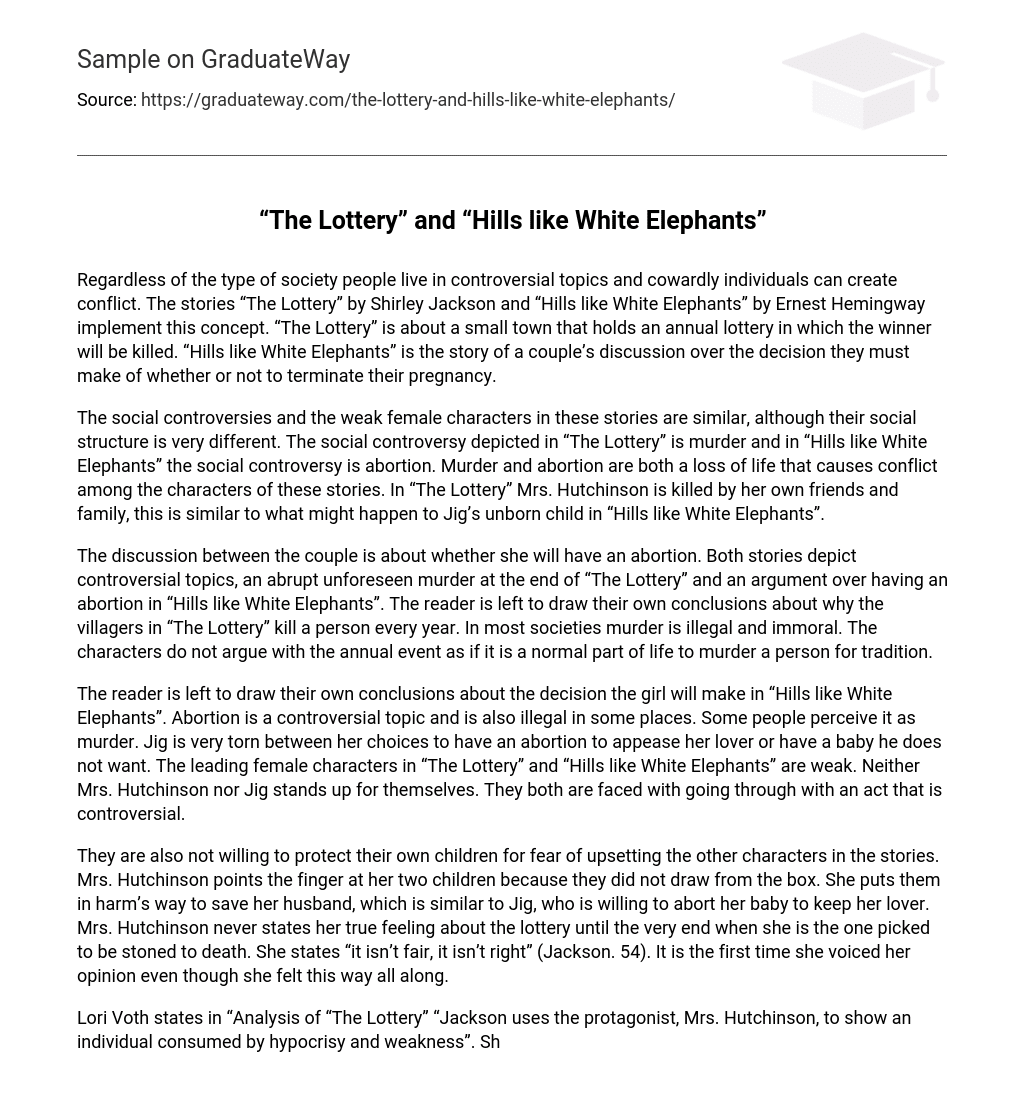No matter the society, contentious subjects and pusillanimous individuals can cause discord. This idea is exemplified in both Shirley Jackson’s “The Lottery” and Ernest Hemingway’s “Hills like White Elephants.” In “The Lottery,” a small town conducts an annual lottery where the chosen individual is sacrificed. Meanwhile, “Hills like White Elephants” depicts a couple deliberating the choice of terminating their pregnancy.
Both “The Lottery” and “Hills like White Elephants” explore social controversies with weak female characters. Although their social structures differ greatly, murder is the social controversy in “The Lottery” while abortion is the social controversy in “Hills like White Elephants”. Both murder and abortion involve a loss of life, causing conflict among the characters. In “The Lottery”, Mrs. Hutchinson is killed by those closest to her, reflecting the potential fate of Jig’s unborn child in “Hills like White Elephants”.
The couple is discussing if the woman should have an abortion. Both “The Lottery” and “Hills like White Elephants” tackle controversial topics – a surprising murder in “The Lottery” and a passionate debate on abortion in “Hills like White Elephants”. In both cases, readers are left to develop their own perspectives on the motives behind the yearly killings in “The Lottery”. Typically, society views murder as illegal and morally reprehensible. Interestingly, the characters in these stories appear to unquestioningly accept murder as a customary tradition.
The decision the girl will make in “Hills like White Elephants” is left for the reader to determine. Abortion, which is illegal in certain places and considered by some as murder, presents a controversial topic. Jig finds herself torn between two options: having an abortion to please her lover or having a baby he does not desire. The female protagonists in “The Lottery” and “Hills like White Elephants” are portrayed as weak, as neither Mrs. Hutchinson nor Jig assert themselves. Both characters are confronted with engaging in an act that generates controversy.
The characters in the stories are not willing to protect their own children because they are afraid of upsetting others. Mrs. Hutchinson places blame on her two children for not drawing from the box, putting them in danger in order to save her husband. This parallels Jig, who is willing to have an abortion to appease her lover. Mrs. Hutchinson never expresses her true feelings about the lottery until the end, when she is chosen to be stoned to death. At that moment, she says “it isn’t fair, it isn’t right” (Jackson. 54). This is the first time she voices her opinion, although she had felt this way all along.
According to Lori Voth’s analysis of “The Lottery”, Jackson utilizes the character of Mrs. Hutchinson to illustrate an individual plagued by hypocrisy and weakness. Despite her understanding that killing someone is inhumane, she lacks the fortitude to voice her objection. Similarly, Jig complies with her lover’s desires, sacrificing her own happiness in the process. She declares, “Then I’ll do it. Because I don’t care about me” (Hemingway. 200). Jig agrees to undergo an abortion despite her personal reluctance, yielding to his wishes. She is also too feeble to express her desire to keep their unborn child, fearful of losing him. Both women demonstrate cowardice.
The social structure is the main difference between “The Lottery” and “Hills like White Elephants”. In “The Lottery”, the townsfolk are portrayed as traditional with strong values, having families and a tight-knit community centered around the well-being of the town. On the other hand, “Hills like White Elephants” depicts a social dynamic focused on the desires of the two individuals. The man resists commitment due to the baby, while the girl fears losing him. They are wanderers without any close relationships or family ties.
Despite the presence of html tags, the meaning and structure of the text can be simplified and unified as follows:
They are portrayed as self-serving individuals who do not prioritize traditional values or family. The stories “The Lottery” and “Hills like White Elephants” share similarities in terms of the social controversy that causes conflict and the weak lead female characters. However, they differ in terms of their social surroundings. One story is set in a traditional town where community needs take precedence, while the other focuses on two self-serving characters who prioritize their own individual needs. Both leading female characters display weakness and an inability to speak up for themselves when faced with social controversy.





